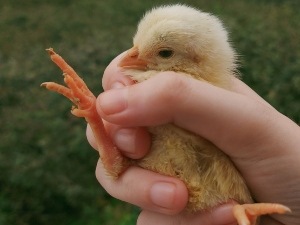
Chickens are at their most vulnerable when they are still chicks, chicks are small, fragile, weak, and can’t defend themselves, a lot of things can kill a chick, diseases included.
If your chick is walking on its hocks you’d be right to be concerned, this article looks into why this is happening.
Table of Contents
Chick walking on hocks:
If you’re raising chicks you need to keep a close eye on them to make sure that they are happy, healthy, active, and are not acting oddly.
An example of odd behavior in chicks is the bird walking on its hocks. Here are reasons why this may be happening:
Curly toe paralysis:
An imbalance in a chick’s diet can cause deformities in the bird.
A diet that is lacking in riboflavin (vitamin B2) may be the reason why your chick is walking and standing on its hocks. Chicks who have a riboflavin deficiency may develop a condition called curly toe paralysis.
The toes of birds suffering from this condition will be curled in, these birds will walk on their hocks and will try to use their wings to walk and support themselves.
If left unattended, the bird will lose its ability to move, it will simply lie on the floor, unmoving in a sprawled position.
Other signs of a vitamin b2 deficiency in chicks include slow growth, rough or dry skin, emaciation, diarrhea, loss of weight, weakness, abnormal droppings, and leg weakness.
What to do:
You can treat the chick by giving it regular doses of vitamin b2. Start off by giving your bird a dose of riboflavin, at a dose of 3.5mg/kg, daily for 5 days. Observe the bird to see if this helps the bird walk properly again.
After the 5 days are up, give the bird a 2.5-3 mg/kg dose of riboflavin daily for a minimum of 7 days.
You can give the bird riboflavin supplementation in the form of poultry vitamins with a riboflavin growth formula. Polyvisol is a vitamin b supplement that is a good source of vitamin b2.
Isolate the affected bird during its recovery time. You can place the bird in a cage, with food and water, until it recovers.
Protect the bird’s hocks by taping cotton pads to the bottom of the bird’s hocks to keep them from scraping the floor.
Create corrective shoes for the bird using cardboard or another firm material. Cut each shoe to fit each of the bird’s feet.
A baby bird’s bones are malleable so you can move the bird’s feet to the correct position and tape them to the corrective shoe.
Slipped tendon
If you didn’t hatch your chicks yourself, if you bought the chicks online, then one of the birds may have become injured on the way.
Buying chicks by mail carries the risk of one or more chicks being crushed or injured on their way to you. If this happened then the bird’s hips or joints may have become twisted or damaged.
The bird may have also developed a slipped tendon if the bird’s diet was nutritionally deficient.
The tendon of a healthy chick should run down the groove on the back of the bird’s hock. If the tendon becomes slipped it will fall to the side of the hock
If the bird’s tendons are not in the correct place then the bird won’t be able to straighten its leg and will, as a result, walk on its hocks or will sit on its hocks.
A chick walking or sitting on its hock is dangerous because this will put weight on the hocks causing swelling on the hocks, and damage to the skin on the hocks.
What to do:
Compare the affected bird’s legs with the legs of the other chicks. If the tendon is not running down the back of the affected chick’s leg, in a straight line, then this means that the tendon is slipped.
Check if she feels any pain in her legs. Do this by lightly, and gently, straightening her legs to see how she reacts.
If the bird has a slipped tendon you won’t be able to fully straighten her leg. The bird will chirp and cry loudly if you try to straighten her leg.
You can reposition the tendon yourself at home. Secure the bird’s hock between one of your fingers and your thumb and roll the joint back and forth. The tendon will snap back into position as you do this, you will feel this when it happens.
Once the chick’s tendon is back in place, and the leg is back to normal, you’d need to secure the bird’s tendon for a little while to keep it in position.
Use sports tape to keep the leg in position. Wrap the tendon in place using several layers of sports tape.
Wrap the tape well but don’t wrap too tightly that you restrict the chick’s circulation. Replace the tape every few days.
FAQ:
How do you know if a baby chick is in pain?
The major signals of pain in your baby bird include peeping or chirping noises. Peeping and chirping signal distress and thus pain.
Other signs of a bird in pain include the bird favoring the side that is not in pain, isolating itself, aggressive behavior, puffed-up feathers, and reduced activity.
How can you tell if a baby chick is unhealthy?
Unhealthy baby chicks are consistently lethargic, they will constantly be sleepy, and they will also not try to move away when you approach them. Moving away is a sign of strength and desire to survive
If you enjoyed this article then you may also be interested in other chicken related articles. Here are some articles that you may be interested in: Chicken Walking On Hocks, Chicken Has A Broken Knee Joint, Chicken Has A Broken Ankle, Chicken Limping And Has Diarrhea, Rooster Has A Broken Leg

